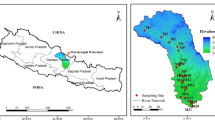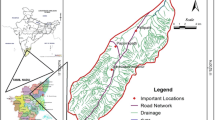Abstract
The Hydrological Simulation Program-Fortran (HSPF), which is a hydrological and water-quality computer model that was developed by the United States Environmental Protection Agency, was employed to simulate runoff and nutrient export from a typical small watershed in a hilly eastern monsoon region of China. First, a parameter sensitivity analysis was performed to assess how changes in the model parameters affect runoff and nutrient export. Next, the model was calibrated and validated using measured runoff and nutrient concentration data. The Nash–Sutcliffe efficiency (E NS ) values of the yearly runoff were 0.87 and 0.69 for the calibration and validation periods, respectively. For storms runoff events, the E NS values were 0.93 for the calibration period and 0.47 for the validation period. Antecedent precipitation and soil moisture conditions can affect the simulation accuracy of storm event flow. The E NS values for the total nitrogen (TN) export were 0.58 for the calibration period and 0.51 for the validation period. In addition, the correlation coefficients between the observed and simulated TN concentrations were 0.84 for the calibration period and 0.74 for the validation period. For phosphorus export, the E NS values were 0.89 for the calibration period and 0.88 for the validation period. In addition, the correlation coefficients between the observed and simulated orthophosphate concentrations were 0.96 and 0.94 for the calibration and validation periods, respectively. The nutrient simulation results are generally satisfactory even though the parameter-lumped HSPF model cannot represent the effects of the spatial pattern of land cover on nutrient export. The model parameters obtained in this study could serve as reference values for applying the model to similar regions. In addition, HSPF can properly describe the characteristics of water quantity and quality processes in this area. After adjustment, calibration, and validation of the parameters, the HSPF model is suitable for hydrological and water-quality simulations in watershed planning and management and for designing best management practices.










Similar content being viewed by others
References
Akter A, Babel MS (2012): Hydrological modeling of the Mun River basin in Thailand. J Hydrol, 232–246
Al-Abed N, Whiteley H (2002) Calibration of the Hydrological Simulation Program Fortran (HSPF) model using automatic calibration and geographical information systems. Hydrol Process 16:3169–3188
Albek M, Ogutveren UB, Albek E (2004) Hydrological modeling of Seydi Suyu watershed (Turkey) with HSPF. J Hydrol 285:260–271
Battin A, Kinerson R, Lahlou M (1998) EPA’s Better Assessment Science Integrating Point and Nonpoint Sources (BASINS)—a powerful tool for managing watersheds, Proc. GISHydro98, Environmental Systems Research, Inc. Users Conference, July, pp. 27–31
Bennett EM, Carpenter SR, Caraco NF (2001) Human impact on erodable phosphorus and eutrophication: a global perspective. Bioscience 51:227–234
Bicknell BR, Imhoff JC, Kittle Jr JL, Jobes TH, Donigian Jr AS, Johanson R (2005) Hydrological Simulation Program–FORTRAN: HSPF Version 12.2 User’s Manual. Environmental Research Laboratory Office of Research and Development US Environmental Protection Agency, Athens
Chinese Academy of Sciences Sustainable Development Strategy Study Group (2007) China Sustainable Development Strategy Report 2007—water: governance and innovation. Science Press, Beijing (in Chinese)
Chung ES, Park K, Lee KS (2011) The relative impacts of climate change and urbanization on the hydrological response of a Korean urban watershed. Hydrol Process 25:544–560
Conley DJ, Paerl HW, Howarth RW, Boesch DF, Seitzinger SP, Havens KE, Lancelot C, Likens GE (2009) ECOLOGY controlling eutrophication: nitrogen and phosphorus. Science 323:1014–1015
Donigian AS (2000) HSPF Training Workshop Handbook and CD, Lecture# 19, Calibration and verification Issues, Slide# L19-22. EPA Headquarters, Washington Information Center, Presented and prepared for US EPA, Office of Water, Office of Science and Technology, Washington, DC
Foley JA, DeFries R, Asner GP, Barford C, Bonan G, Carpenter SR, Chapin FS, Coe MT, Daily GC, Gibbs HK, Helkowski JH, Holloway T, Howard EA, Kucharik CJ, Monfreda C, Patz JA, Prentice IC, Ramankutty N, Snyder PK (2005) Global consequences of land use. Science 309:570–574
Gao Y, Zhu G, He R, Wang F (2009) Variation of water quality and trophic state of Lake Tianmu, China. Environ Sci 30:673–679 (in Chinese)
Goncu S, Albek E (2010) Modeling climate change effects on streams and reservoirs with HSPF. Water Resour Manag 24:707–726
Jin X (2001) Lake eutrophication control and management techniques. Chemical Industry Press, Beijing (in Chinese)
Kim SM, Park SW, Lee JJ, Benham BL, Kim HK (2007) Modeling and assessing the impact of reclaimed wastewater irrigation on the nutrient loads from an agricultural watershed containing rice paddy fields. J Environ Sci Health A Toxic/Hazard Subst Environ Eng 42:305–315
Kleijnen JP (2005) An overview of the design and analysis of simulation experiments for sensitivity analysis. Eur J Oper Res 164:287–300
Lee SB, Yoon CG, Jung KW, Hwang HS (2010) Comparative evaluation of runoff and water quality using HSPF and SWMM. Water Sci Technol 62:1401–1409
Li Z, Liu H, Li Y (2012) Review on HSPF model for simulation of hydrology and water quality processes. Environ Sci 33:2217–2223 (in Chinese)
Liu J, Yang W (2012) Water sustainability for China and beyond. Science 337:649–650
Liu Z, Tong STY (2011) Using HSPF to model the hydrologic and water quality impacts of riparian land-use change in a small watershed. J Environ Inf 17:1–14
Mishra A, Kar S, Singh VP (2007) Determination of runoff and sediment yield from a small watershed in sub-humid subtropics using the HSPF model. Hydrol Process 21:3035–3045
Mitsch WJ, Day JW, Gilliam JW, Groffman PM, Hey DL, Randall GW, Wang NM (2001) Reducing nitrogen loading to the Gulf of Mexico from the Mississippi River Basin: Strategies to counter a persistent ecological problem. Bioscience 51:373–388
Oyarzun R, Arumi J, Salgado L, Marino M (2007) Sensitivity analysis and field testing of the RISK-N model in the Central Valley of Chile. Agric Water Manag 87:251–260
Praskievicz S, Chang H (2011) Impacts of climate change and urban development on water resources in the Tualatin River Basin, Oregon. Ann Assoc Am Geogr 101:249–271
Tong STY, Sun Y, Ranatunga T, He J, Yang YJ (2012) Predicting plausible impacts of sets of climate and land use change scenarios on water resources. Appl Geogr 32:477–489
Woodward G et al (2012) Continental-scale effects of nutrient pollution on stream ecosystem functioning. Science 336:1438–1440
Yang G, Yu X, Li H, Gao J (2004) Introduction to integrated watershed management. Science Press, Beijing (in Chinese)
Yang YS, Wang L (2010) A review of modelling tools for implementation of the EU Water Framework Directive in Handling Diffuse Water Pollution. Water Resour Manag 24:1819–1843
Zhang T (2010) A spatially explicit model for estimating annual average loads of nonpoint source nutrient at the watershed scale. Environ Model Assess 15:569–581
Zhu W (2003) Resources and environment in the Yangtze Basin. J Lake Sci 15:133–138 (in Chinese)
Acknowledgments
The authors gratefully acknowledge the financial support of the National Natural Sciences Foundation of China (41171071, 41030745), the Priority Academic Program Development of Jiangsu Higher Education Institutions (PAPD), the “135 Plan” Key Project of Nanjing Institute of Geography and Limnology, the Chinese Academy of Science (NIGLAS2012135005), and the Scientific Research Foundation for the Returned Overseas Chinese Scholars, State Education Ministry.
Author information
Authors and Affiliations
Corresponding author
Additional information
Responsible editor: Michael Matthies
Rights and permissions
About this article
Cite this article
Li, Z., Liu, H., Luo, C. et al. Simulation of runoff and nutrient export from a typical small watershed in China using the Hydrological Simulation Program–Fortran. Environ Sci Pollut Res 22, 7954–7966 (2015). https://doi.org/10.1007/s11356-014-3960-y
Received:
Accepted:
Published:
Issue Date:
DOI: https://doi.org/10.1007/s11356-014-3960-y




